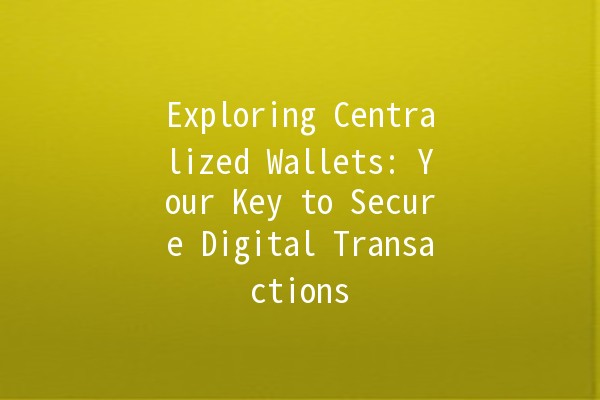
In the rapidly evolving world of cryptocurrencies, centralized wallets play a pivotal role for both newcomers and seasoned investors. Understanding these wallets can significantly enhance your digital currency management. This article delves into the intricacies of centralized wallets, offering actionable tips to maximize your productivity and security while using them.
What is a Centralized Wallet?

Centralized wallets are platforms that store users' cryptocurrency securely on behalf of the user. Unlike decentralized wallets, where you have full control over your private keys, centralized wallets require trust in a third party to manage the cryptocurrencies. These wallets often come linked with an exchange, which facilitates trading and other transactions.
Key Characteristics:
UserFriendly Interface: Designed for ease of use, making them ideal for beginners.
Integrated Trading Features: Often allow users to trade cryptocurrencies directly within the wallet.
Support for Multiple Currencies: Many centralized wallets support various cryptocurrencies, enhancing user experience.
The Importance of Centralized Wallets
Centralized wallets provide a way to easily store, manage, and trade cryptocurrencies. They also offer customer support, making them a safer option for beginners. However, the reliance on thirdparty security means users must choose their wallet provider carefully.
Five ProductivityEnhancing Tips for Using Centralized Wallets
Explanation:
TwoFactor Authentication provides an additional layer of security, ensuring that even if someone gets hold of your password, they cannot access your wallet without the second layer of verification.
Practical Application:
To enable 2FA:
Choose a wallet that supports 2FA.
Use apps like Google Authenticator or Authy.
Follow the wallet’s instructions to link your 2FA app.
This simple step can dramatically reduce the risk of unauthorized access.
Explanation:
Keeping your wallet software up to date ensures you benefit from the latest security features, bug fixes, and improvements.
Practical Application:
Enable automatic updates if available.
Subscribe to your wallet provider’s notification service to stay informed about important updates.
Regular updates are crucial in protecting your assets from vulnerabilities and threats.
Explanation:
Having multiple wallets helps mitigate risks associated with potential hacks or failures of a single wallet provider.
Practical Application:
Maintain a centralized wallet for frequent transactions.
Consider using a hardware wallet for longterm storage, which is isolated from online threats.
Diversification allows for better risk management, protecting your investments.
Explanation:
Regular backups of your wallet prevent loss of access due to device loss or wallet provider failure.
Practical Application:
Utilize your wallet's backup function to create a recovery phrase or seed phrase.
Store the backup in a secure location, both physically (like a safe) and digitally (in a passwordprotected cloud service).
This proactive measure ensures that you can recover your assets even in trying circumstances.
Explanation:
Safe trading practices can prevent unauthorized transactions and protect your wallet from scams.
Practical Application:
Only trade on reputable exchanges.
Avoid sharing sensitive information online, especially on forums and social media.
Always doublecheck addresses before sending funds.
Being vigilant about security can save you from potential losses and scams.
Frequently Asked Questions
Centralized wallets require trust in a third party to manage your assets and usually provide simpler user experiences. In contrast, decentralized wallets give you complete control over your private keys, but are often less userfriendly.
While centralized wallets can be safe, they come with risks, such as being potential targets for hacks. Ensuring that your wallet uses strong security features and practicing good security habits can enhance safety.
Many centralized wallets can be integrated with other services, such as payment processors and exchanges, enhancing their usability for daily transactions and trading.
Most centralized wallets have recovery processes that may involve answering security questions or using a backup email address. If you have enabled 2FA, you may need access to your 2FA method as well.
Yes, you can withdraw your cryptocurrencies from a centralized wallet to another wallet or exchange. Each wallet has a withdrawal procedure, which typically involves providing a withdrawal address and confirming the transaction.
Like any online service, centralized wallets can be susceptible to hacks. However, using wallets with robust security measures, keeping software updated, and employing strong passwords can reduce this risk.
Utilizing a centralized wallet can simplify your cryptocurrency experience, allowing for secure transactions and effortless management of digital assets. By implementing the productivity tips outlined above, you can enhance your security and efficiency, ensuring a smoother cryptocurrency journey. Embrace the digital future with confidence and make informed decisions to protect and grow your assets in the crypto space!

